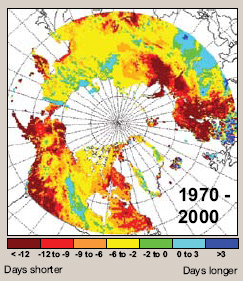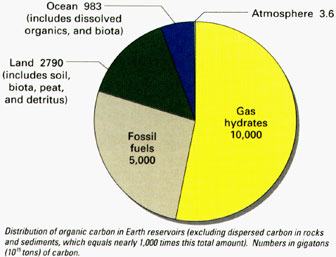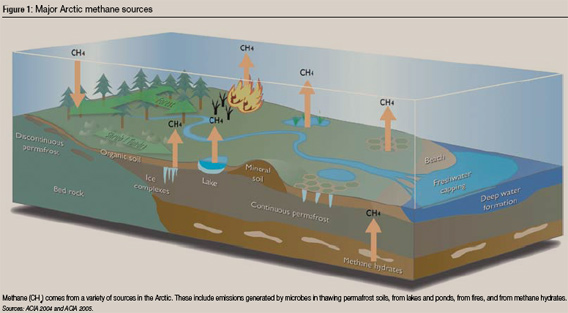Melting of permafrost could trigger rapid global warming warns UN
Melting of permafrost could trigger rapid global warming warns UN
mongabay.com
February 21, 2008
|
|
Melting of the Arctic permafrost is a “wild card” that could dramatically worsen global warming by releasing massive amounts of greenhouse gases, warned the U.N. on Wednesday at a meeting in Monaco.
Vast amounts of methane, a greenhouse gas 23-25 times more potent than carbon dioxide, are locked in the deep sea and in the frozen soils of Siberia, Northern Europe, and North America, but warming could trigger rapid thawing that would release billions of tons into the atmosphere.
“Methane release due to thawing permafrost in the Arctic is a global warming wildcard,” stated The UNEP Year Book 2008. “The balance of evidence suggests that Arctic feedbacks that amplify warming, globally and regionally, will dominate during the next 50 to 100 years. As warming continues, these feedbacks will likely intensify. We may be approaching thresholds that are difficult to predict precisely, but crossing such thresholds could have serious global consequences.”

Change in duration of snow-covered ground north of 50°N. The number of days in a year in which the ground is snow covered has decreased by an estimated average of 7.5 days from 1970 to 2000. Source: Euskirchen and others 2007, image courtesy of UNEP |
“It is already clear that the global climate is vulnerable to Arctic feedbacks and that the consequences of those feedbacks could be disastrous. The only way to reduce the magnitude of these consequences is to dramatically reduce and stabilize concentrations of GHGs in the atmosphere,” the report continued. “The potential consequences of large amounts of methane entering the atmosphere, from thawing permafrost or destabilized ocean hydrates, would lead to abrupt changes in the climate that would likely be irreversible. We must not cross that threshold. Reversing current human induced warming will help us avoid such outcomes entirely.”
The report also noted that methane hydrates “are a potentially large stockpile of clean-burning fuel, if ways can be found of mining them safely and economically.” Already firms are looking at strategies for exploiting methane hydrates as an energy source.
 Hydrates store immense amounts of methane, with major implications for energy resources and climate, but the natural controls on hydrates and their impacts on the environment are very poorly understood. Gas hydrates occur abundantly in nature, both in Arctic regions and in marine sediments. Gas hydrate is a crystalline solid consisting of gas molecules, usually methane, each surrounded by a cage of water molecules. It looks very much like water ice. Methane hydrate is stable in ocean floor sediments at water depths greater than 300 meters, and where it occurs, it is known to cement loose sediments in a surface layer several hundred meters thick. The worldwide amounts of carbon bound in gas hydrates is conservatively estimated to total twice the amount of carbon to be found in all known fossil fuels on Earth. This estimate is made with minimal information from U.S. Geological Survey (USGS) and other studies. Extraction of methane from hydrates could provide an enormous energy and petroleum feedstock resource. Additionally, conventional gas resources appear to be trapped beneath methane hydrate layers in ocean sediments. IMAGE AND CAPTION TEXT COURTESY OF USGS |
The U.N. said that global methane emissions from all sources, both natural and human-induced, are estimates at 500-600 million metric tons per year, of which 150 to 250 million metric tons comes from the
world’s soils. Estimates of the total amount of methane hydrates in permafrost soils range from 7.5 to 400 billion metric tons of carbon. Oceanic hydrate deposits are estimated from 2,000 to 10,000 billion metric tons. For comparison, global fossil fuel reserves are estimated at 5,000 billion metric tons.
Most methane emissions never reach the atmosphere — they are broken down by ultraviolet radiation. For methane that does reach the atmosphere, the gas has a lifetime of about eight years. In contrast, carbon dioxide can last a century in the atmosphere. As such, atmospheric methane levels can be quickly reduced, while carbon dioxide accumulates and presents a long-term problem. Still, methane levels have more than doubled since the beginning of the Industrial Revolution in the 18th century, and annual emissions have again begun to creep up after declining in the 1990s. Further, when methane oxidizes, its carbon element still affects the climate as carbon dioxide. The U.N. report notes “the consequences of increased amounts of methane entering the atmosphere depend on whether it is released instantaneously or at a slow, chronic pace.”
